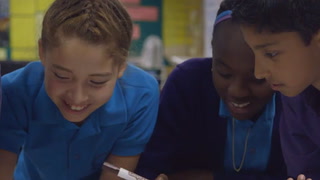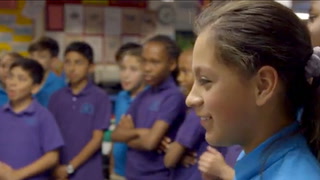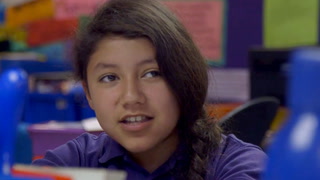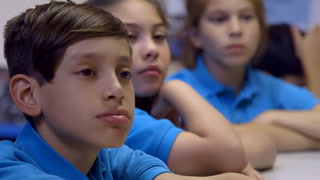Evaluating Art Through Different Lenses Transcript
ANTOINETTE PIPPEN [sync]
00:00:03 Who can tell me what subjective means?
BRAID
If you see a flower and you say it’s pretty, that might mean subjective.
ANTOINETTE PIPPEN [sync]
So, that’s an example of subjective. Our friend, Ariana, she’s wearing a headband. Is that true? Do we all agree on that?
STUDENTS
Yes.
ANTOINETTE PIPPEN [sync]
00:00:18 So, that’s objective. If I say, “It’s a vibrant headband that I think is very nice,” is that objective or subjective?
CLASS
Subjective.
00:00:30 [TITLE: Arts Integration: Evaluating Art Through Different Lenses]
ANTOINETTE PIPPEN
00:00:33 The learning objective was for students to be able to evaluate and compare different works of art through different lenses. So, looking at the art as an artist and using artistic words and looking and analyzing it through a scientific lens and using technical or scientific words.
00:00:50 We talk about how there are different ways to know the world. There’s the subjective, my experience way of knowing the world, but then there’s also the objective or the scientific way of knowing the world.
ANTOINETTE PIPPEN [sync]
00:01:03 In science, we try to know things with our eyes, understanding the natural world. Maybe not the emotional world. But in art it’s more philosophical and it’s more personal. Right? We can know the world through art and we can know the world through science, but both of these things, humans do to understand the world.
00:01:23 They’re just different ways of knowing and we use different types of words.
ANTOINETTE PIPPEN
00:01:27 They’ve already had instruction on the elements of art. They are very fluent in many of the different words we use to describe art. And they also have a lot of background knowledge in science. We’ve done different informative readings on biodiversity, elements of a ecosystem, so I just reviewed the scientific words, just to have them primed for them.
00:01:49 And then we started by looking at, as a whole group, one work of art that portrays nature. The style of art is artistic, but it’s influenced by scientific drawing.
00:02:02 [TITLE: STEP 1]
[TITLE: Discuss artwork as a whole group.]
ANTOINETTE PIPPEN [sync]
00:02:03 So, what do you see here? Juan?
JUAN
00:02:06 I see a pear. I think it’s a caterpillar on top of it.
ANTOINETTE PIPPEN [sync]
00:02:11 Jessica?
JESSICA
I agree with Juan that the fruit might be a pear.
00:02:15 [TITLE: Common Core Standard]
[TITLE: Respond to questions and elaborate on the remarks of others]
JESSICA
00:02:18 Because pears do have that kind of shape. I also think the insects might be eating it. I can see, like, a small dent or bite mark on the pear.
ANTOINETTE PIPPEN
00:02:30 We had a group conversation. This gives them an opportunity to hear each other, to have me listen and paraphrase and ask them certain guiding questions that should get them thinking about the paintings and the pictures in a particular way.
ANTOINETTE PIPPEN [sync]
00:02:46 So, I heard you, Jessica, mention insects. What do we know scientifically about insects?
STUDENT
All insects have six legs. We can tell by their legs and their antennas.
ANTOINETTE PIPPEN [sync]
00:03:01 Okay, so there’s some attributes that we can use to classify what we call insects.
ANTOINETTE PIPPEN
00:03:06 So, after the group discussion, the students go and work in small groups. I’ve given them posters and different prints, but they’re all depictions of nature.
ANTOINETTE PIPPEN [sync]
00:03:18 I’m going to give your group ten minutes. See as many things as you can with your artist’s eyes and see as many things as you can with your scientist’s eyes. Using those words, okay? Everyone get in your group.
ANTOINETTE PIPPEN
00:03:30 The groups discuss amongst themselves what is artistic, what is scientific. And they’re evaluating. So, you can hear them asking, “Okay, is that artistic?” Is that scientific”?
STUDENT
00:03:43 What’s artistic or scientific?
00:03:45 [TITLE: STEP 2]
[TITLE: Discuss artwork in small groups.
JOSUE
00:03:45 Something scientific is that in reality, there are plants like the Venus flytrap. It’s gonna eat this mosquito because it’s opening its mouth.
STUDENT
00:03:59 And it’s like it’s holding the mouth open.
JOSUE [sync]
Oh, like it’s strong.
JOSUE
00:04:05 Working in our group helped me because I can see different points of view of other kids in my class. I noticed that you can see them in a different way.
FRENCH BRAID GIRL
00:04:16 The- Something artistic is like the face looks all smushed up.
ANTOINETTE PIPPEN
00:04:23 So, using, you know, that T-chart, they are going to make sure that they’re seeing through different lenses. And they can monitor and see, “Oh, I have got a lot of artistic and I need scientific now.”
ARIANA
00:04:37 No, it was [unintell] artistic.
STUDENT
Oh yeah, it was [unintell]
00:04:40 [TITLE: CLASSROOM STRATEGY]
[TITLE: The T-Chart helps students keep the different perspectives organized]
ARIANA
00:04:45 What do you guys think – do you think this mosquito- or that-
STUDENT
Dragonfly.
ARIANA
Yeah, dragonfly. Is standing there?
STUDENT
Oh, because it looks like it’s hanging.
ARIANA
Like it’s hanging upside down. It’s like a bat.
FRENCH BRAID
00:04:55 So, is that, like, its head? No, artistic.
ARIANA
Yeah because it can’t be scientific.
JOSUE [sync]
Scientific, I think, because, Ariana, it has the- the patterns of the wings.
ARIANA
00:05:04 That’s-
FRENCH BRAID
That’s what I already said, already.
ANTOINETTE PIPPEN
00:05:06 I also give them all different color markers. That’s a strategy to ensure that all students are participating because they’re accountable for their color showing up on the poster.
00:05:17 [TITLE: CLASSROOM STRATEGY]
[TITLE: Writing in different color markers ensures all students participate]
ANTOINETTE PIPPEN [sync]
00:05:20 So, now, we’re going to share with the class. I want you to be sure to project your voices, look at your audience, talk to the people sitting and watching you. So, everyone share one scientific thing and one artistic thing.
00:05:34 [TITLE: STEP 3]
[TITLE: Small groups present their findings.]
JOSUE [sync]
00:05:34 I think that something scientific is that the pink plant looks like it’s going to eat the mosquito like a Venus flytrap.
ANTOINETTE PIPPEN [sync]
00:05:45 Josue, you said it looks like it’s going to eat the insect. Does every agree that’s scientific?
CLASS
No.
ANTOINETTE PIPPEN [sync]
00:05:52 Can someone say why they either agree or disagree with that? Amina?
AMINA
00:05:57 I disagree that it looks like the flower’s going to eat the moth because maybe the flower is just made like that and the moth is just flying right there.
ANTOINETTE PIPPEN
00:06:11 Using visual art is a scaffold for students that maybe aren’t able to obtain all of the literary information from the text. But when we’re having these class discussions, they are talking and engaging with their peers. It gives many more students access to the discourse that’s happening in the class.
00:06:29 After they were done presenting and sharing, we engaged in a quick discussion about which one of the works of art was most scientific.
00:06:38 [TITLE: STEP 4]
[TITLE: Compare and contrast the artwork as a whole group.]
ANTOINETTE PIPPEN [sync]
00:06:39 And so, now, which one of these do you think is most scientific?
JOSUE
I think that one’s the most scientific. There’s a butterfly and a whole bunch of flowers. And you usually see butterflies with flowers.
ANTOINETTE PIPPEN
00:06:52 The students are getting a lot more science and scientific thinking through studying art. It frees them to think about things from different perspectives and it allows them to understand that there’s no right or wrong answer, necessarily, but there’s better justified answers, there’s more evidence for particular answers.
00:07:12 And that’s really the same in art and science.
ANTOINETTE PIPPEN [sync]
00:07:16 We have different opinions. Now, think about it from the other perspective. And so, you’re going to write a paragraph – which one of these is the most artistic? So, I want you to turn and talk to your partner and talk about which one of these you think is most artistic.
00:07:34 [TITLE: STEP 5]
[TITLE: Discuss opinions with a partner.]
BRAID
00:07:34 The most artistic is the flowers because it actually shows a lot of color and a lot of saturation.
ANTOINETTE PIPPEN
00:07:44 The Common Core standards of being able to make observations, debate, articulate your opinions, and provide evidence – those are everywhere in art and science. But if you can give students more opportunities to talk and discuss, not matter what it’s about, they’re going to become better writers and better readers.
00:08:04 Then the final piece, when they were writing their paragraph, the structure is there, the arguments are there. They’re able to construct substantiated arguments.
00:08:14 [TITLE: STEP 6]
[TITLE: Write an opinion piece about the artwork from a specific lens]
ANTOINETTE PIPPEN [sync]
00:08:14 You all have a piece of paper. Thank you, Ariana. You’re going to evaluate. And then using your artistic and scientific words, you’re going to make an argument – which one of these, you pick, is the most artistic to you. And you may begin.
00:08:32 You can come up with whatever title you would like.
00:08:33 [TITLE: Common Core Standard]
[TITLE: Write opinion pieces supporting a point of view with reasons.]
JOSUE
00:08:36 What was hard for me was explaining why I thought the still life with dead birds in it was more artistic than the rest of them. I worked through it by looking at all the details it had.
JOSUE [sync]
00:08:51 I think that the painting that looks the most artistic is the first one. It has all of the animals looking dead and the dead birds make it look like a cartoon.
ANTOINETTE PIPPEN [sync]
00:09:07 Any questions or comments for Josue?
STUDENT
Something scientific that I noticed was that, like, it shows the patterns and, like, the texture of the wings when you look up closer to it.
ANTOINETTE PIPPEN
00:09:19 I definitely see that art, it’s enriching their capacity to understand and grow as scientists. You know, when we’re looking at depictions of wildlife and nature, we’re talking about life science. Or the landscapes, we’re talking about earth science. The more depictions of nature that they can see, the deeper understanding the students will be able to obtain.
00:09:48 ***FILE END***













6 Comments
Mei-Yun Gibson Nov 29, 2016 6:33pm
Nidhi Cash May 11, 2016 8:25pm
Valerie Robertson Feb 21, 2015 4:39pm
Najla Aladwani Dec 20, 2014 10:29am
Laurie DeMatteo Dec 8, 2014 3:39pm